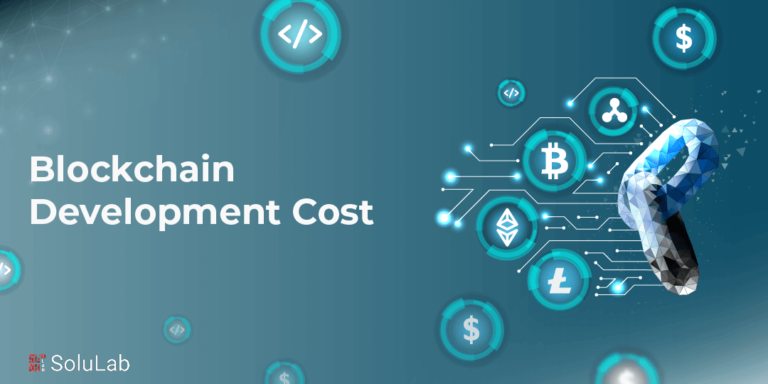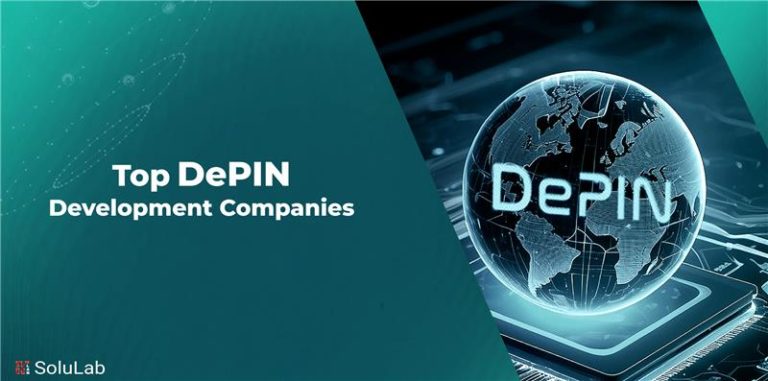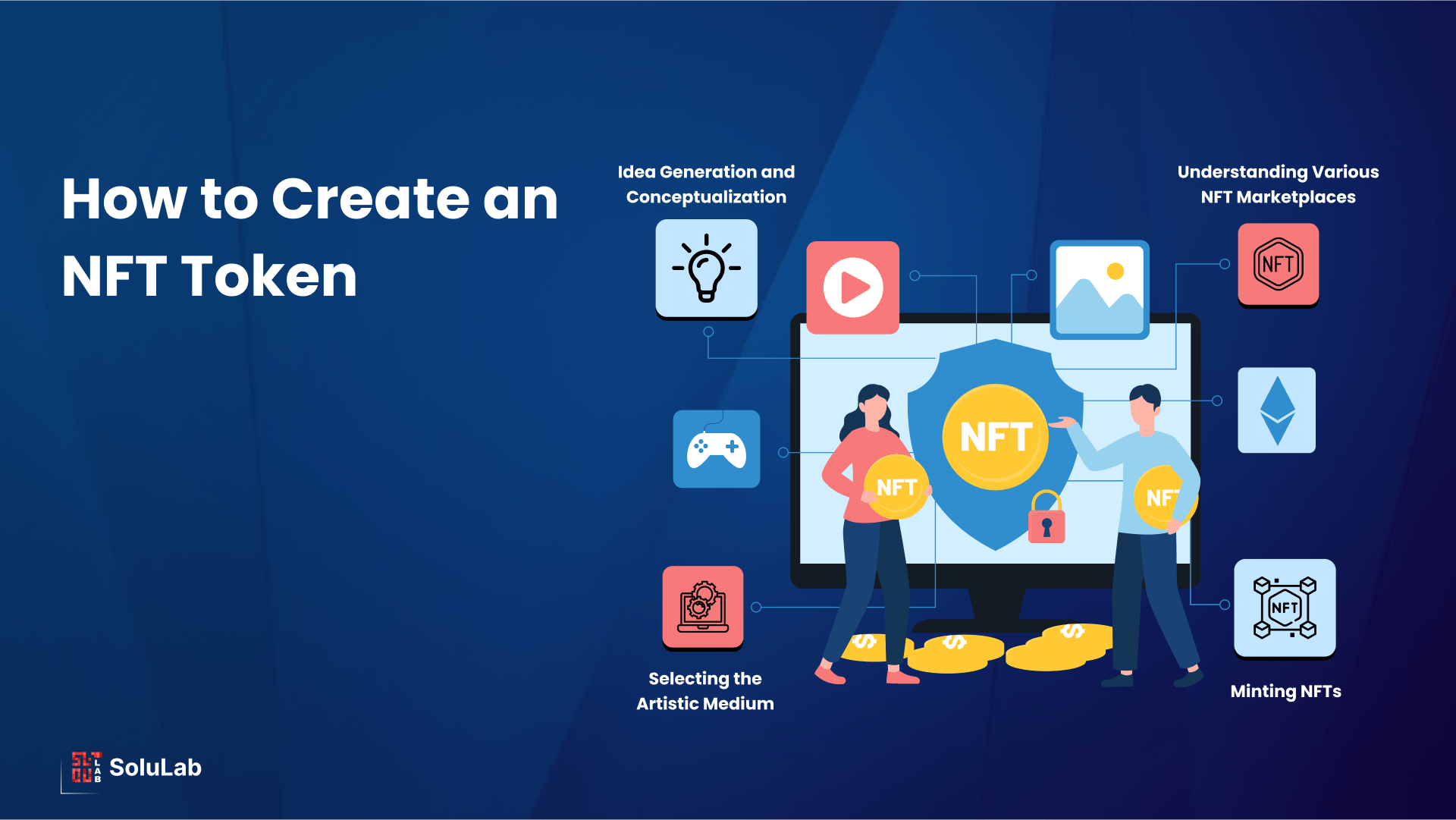
The surge in popularity of non-fungible tokens (NFTs) has opened up new avenues for digital artists and creators to exhibit and monetize their work. NFTs provide a distinctive method for creators to establish ownership, authenticity, and scarcity for their digital creations through blockchain technology.
Through the minting (creation) and sale of their content as NFTs, creators can establish a direct connection with their audience, bypassing intermediaries such as galleries or agents. This approach empowers them to retain a larger share of their work’s earnings and exert greater control over their artistic endeavors. Whether you’re an artist, musician, writer, or any other type of creator, it’s crucial to grasp the process of creating an NFT to leverage the potential offered by this rapidly evolving market.
In this blog, we will delve into the intricate process of how to create my own NFT token in 2025. Let’s have a look at this journey as we unravel the steps, strategies, and insights necessary to harness the full potential of NFTs in 2025 and beyond. The future of digital creation awaits, and it’s time to embrace the power of NFTs!
Why Create Your NFT Token?
Creating your own NFT Token in 2025 remains an enticing pursuit for various compelling reasons, mirroring the ongoing shifts and advancements in the digital arena. Several key motivators drive the creation of NFTs this year, reflecting the dynamic trends shaping the digital landscape, such as:
1. Asset Portfolio Diversification: NFTs present an exclusive avenue for diversifying digital asset portfolios. By tokenizing diverse content forms like art, music, virtual real estate, and more, creators and investors can broaden their portfolios beyond conventional assets, potentially optimizing their overall investment strategy.
2. Monetization Opportunities for Creators: NFTs empower creators across multiple industries, providing a direct avenue to monetize their digital creations. Musicians, artists, game developers, and content creators can leverage NFTs to receive immediate compensation for their works, reducing reliance on traditional intermediaries and opening up fresh revenue streams.
3. Gaming Industry Innovation: The gaming sector has embraced NFTs to establish true ownership of in-game assets. NFTs enable gamers to buy, sell, and trade virtual items across various games, cultivating a lively ecosystem of digital asset ownership within the gaming community.
4. Virtual Real Estate and Metaverse Advancements: In tandem with the burgeoning metaverse concepts, NFTs play a pivotal role in representing ownership of virtual land and properties. Creating NFTs associated with virtual real estate allows dedicated developers to partake in the thriving metaverse economy, where users immerse themselves in digital experiences.
5. Digital Identity and Authentication: NFTs provide a secure and verifiable means to represent digital identity and authenticate digital assets. This finds applications in certifications, licenses, and credentials, establishing a tamper-resistant and transparent record of ownership or accomplishment.
6. Integration with Web3 Technologies: The ongoing evolution of Web3 technologies and decentralized applications (DApps) creates a conducive environment for NFTs. Integrating NFTs with Web3 enhances decentralization, user autonomy, and overall user experiences across diverse applications and platforms.
7. Community Engagement: NFTs foster direct connections between creators and their audience, amplifying community engagement. Token holders often become integral members of a community united by shared interests and values, fostering increased collaboration, loyalty, and support for the creator’s work.
8. Interoperability and Cross-Platform Integration: NFT standards such as ERC-721 and ERC-1155 facilitate interoperability, enabling NFTs to seamlessly transfer and function across various platforms and ecosystems. This interoperability amplifies the liquidity and utility of NFTs, rendering them more appealing to creators and users alike.
Embarking on the creation of NFTs in 2025 offers an exhilarating chance to engage with a vibrant and swiftly transforming digital environment. Whether it’s for broadening investment portfolios, enabling creators to directly monetize their work, or contributing to emerging technologies like the metaverse, create NFT tokens to persist in influencing the trajectory of digital ownership and interaction.
How to Prepare for NFT Creation?
Embarking on the journey to create your own NFT necessitates a comprehensive understanding of the process before taking the plunge. Here’s a strategic approach to guide you through the initial stages:
1. Idea Generation and Conceptualization
To kickstart the NFT creation process, it’s imperative to lay a robust foundation by beginning with a unique and compelling idea. Prioritize brainstorming and conceptualizing your NFT, ensuring it stands out and resonates with potential buyers and collectors.
Crafting an original NFT is key—offer something distinctive and valuable, capturing the attention and interest of your target audience to meet market demand effectively. Fuel your creativity by exploring various sources of inspiration. Engage in conversations with fellow artists and creators within the NFT community to exchange ideas and gain fresh perspectives. Stay attuned to the latest trends and developments by following NFT marketplace, social media accounts, and online communities dedicated to digital art and collectibles.
Delve into NFT art platforms, galleries, and marketplaces to glean insights from successful projects. Analyze the factors contributing to the popularity of existing NFTs, leveraging this knowledge to refine your approach. By immersing yourself in the NFT ecosystem, you’ll find inspiration and unlock new possibilities for your upcoming NFT project.
2. Selecting the Artistic Medium for NFT Creation
When preparing to create NFTs, explore diverse artistic mediums, such as digital art, music, and videos, to discern which aligns seamlessly with your creative vision and technical expertise. Identify the medium that best amplifies the impact and authenticity of your art. Opt for a medium that allows you to articulate your ideas effectively; for instance, if you are adept at digital tools, digital art might be the natural choice. Conversely, if you possess skills in music production or video editing, leverage those capabilities to craft innovative NFT content.
Regardless of the chosen medium, prioritize producing high-quality and resolution-independent work. Since NFTs are consumed on various devices, from large screens to mobile phones, ensuring your work maintains its visual appeal and fidelity across different resolutions and screen sizes is paramount for preserving its value and influence.
Devote time to refining the composition, color scheme, and overall presentation to elevate your NFTs in a competitive market.
3. Understanding the Various NFT Marketplaces
When it comes to selling and trading NFTs, a crucial aspect is understanding the distinct features of various NFT marketplaces to choose the one aligning with your artwork and objectives. Some prominent NFT marketplaces include:
- OpenSea: Positioned as one of the largest and most renowned NFT marketplaces, OpenSea boasts an extensive array of digital assets, spanning art, collectibles, virtual real estate, and more. Recognized for its user-friendly interface, OpenSea facilitates easy minting and listing of NFTs. Offering customization options and compatibility with multiple blockchains, OpenSea’s drawback lies in the extensive number of listings, posing a challenge for new artists to gain visibility.
- Rarible: Geared towards artists and collectors, Rarible stands out for its user-friendly platform featuring customizable NFT attributes, royalty settings, and a social feed for community engagement. Prioritizing community governance, Rarible operates on the Ethereum blockchain, leading to high gas fees. However, a lack of curation can present challenges for high-quality projects to distinguish themselves.
- SuperRare: Positioned as a curated marketplace, SuperRare focuses on high-quality, single-edition digital artworks. Offering a selective approach, the platform prioritizes an immersive experience for collectors, highlighting scarcity and uniqueness. SuperRare incorporates an auction system for exclusive artworks, yet its exclusive curation creates a notable barrier to entry for artists seeking to join the platform.
When choosing the ideal NFT marketplace for your artwork and objectives, it’s crucial to factor in the artistic medium, as certain platforms specialize in specific mediums, such as digital art or music. Assess whether the platform aligns with your target audience.
Examine the community and audience of each marketplace to determine if it attracts collectors and enthusiasts who genuinely appreciate and value your type of artwork. Scrutinize the features and customization options offered by each platform, and gain a comprehensive understanding of their fee structures and revenue-sharing models to ensure they align with your goals. Prioritize platforms with a proven track record, positive user reviews, and a commitment to supporting artists and creators. Taking these considerations into account will help you make an informed decision when selecting a platform that best suits your artwork and aspirations.
Creating and Minting NFTs: A Step-by-Step Guide
Embarking on the journey of creating and minting an NFT involves a series of steps to ensure your content is ready for upload and generation. Here’s a comprehensive guide:
-
Creating Content
Before you can mint your NFT, it’s crucial to prepare your content to meet technical requirements and optimize its presentation on digital platforms.
NFT marketplaces typically accept common image formats such as JPEG, PNG, or GIF for static images and MP4, GIF, or WEBM for animations and videos. Ensure your work aligns with the required format for your chosen marketplace. Develop high-resolution content with dimensions suitable for seamless display across various devices.
To enhance user experience, compress the file size without compromising quality, as larger files can result in slower loading times. Maintain the original aspect ratio of your artwork to prevent distortion when displayed on different devices and platforms.
Consider incorporating a watermark into your work to safeguard it from unauthorized use or plagiarism. Establish authenticity by digitally signing the work or including your signature within the composition.
-
Choosing the Right Blockchain Network for NFT Minting
Opting for a suitable blockchain network stands as a pivotal step in the process of minting your NFT. Well-known blockchain networks for NFTs encompass Ethereum, Solana, Binance Smart Chain, and Flow.
Each network possesses distinct characteristics and ecosystems, prompting the need to assess factors like transaction fees, scalability, user base, and community support. The cost associated with creating an NFT varies significantly among networks, prompting the selection of one aligning with your budgetary constraints and objectives.
After settling on a blockchain network, initiate the creation of an NFT wallet. Numerous NFT-compatible wallets cater to diverse needs and preferences. For Ethereum-based NFTs, options like MetaMask or Trust Wallet are available, while Binance Wallet serves as the official wallet for BNB Chain NFTs.
Minting Your NFT: Step-by-Step Process
To mint an NFT, follow these step-by-step instructions:
1. Connect Your Wallet: After creating your best NFT wallets, link it to your selected NFT marketplace. On platforms like OpenSea and Rarible, click the Create button, select your wallet from the provided list, and adhere to the prompts.
2. Prepare Metadata and Information: For each NFT listing, include essential metadata and information. This encompasses the title, description, tags, and any additional attributes or properties specific to the content.
3. Specify Royalties and Pricing: Set the desired royalties for every resale of your NFT. Take into account the marketplace’s royalty mechanisms and establish a fair initial pricing for your NFT.
4. Decide on the Edition: Determine whether your NFT will stand as a unique piece or part of a limited-edition series. Clearly state the total number of editions available.
5. Mint: Abide by the marketplace’s guidelines to generate and upload your NFT. This typically involves uploading the artwork, entering necessary information and metadata, and confirming the transaction by the provided instructions.
NFT Marketing Strategies for Maximum Impact
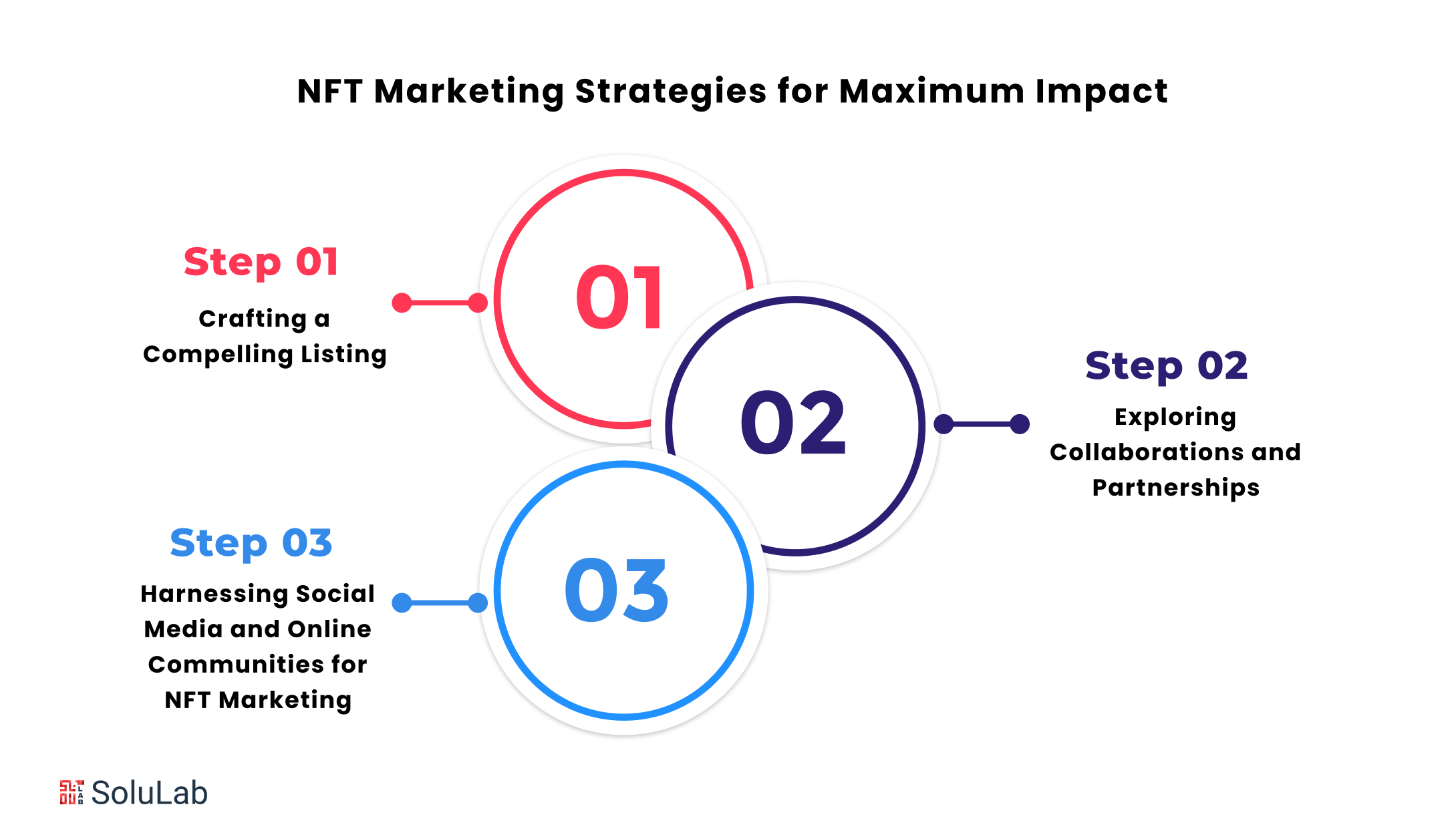
Effectively marketing and promoting your NFT is vital to distinguish your work in a competitive marketplace, create a buzz around your creations, and draw in potential buyers.
-
Crafting a Compelling Listing
Developing a listing that captivates the viewer increases the likelihood of them making a purchase or placing a bid on your work. Construct a title that not only captures attention but also accurately represents your content. Utilize descriptive and captivating language to provoke curiosity and generate interest.
Compose a compelling description that narrates the story behind your work. Share insights into your inspiration, artistic process, and the distinctive aspects that make your NFT noteworthy.
Offering a glimpse into your journey as an artist can establish a connection, fostering trust and interest among collectors. Incorporate high-resolution images featuring different angles, close-ups, and detailed shots to comprehensively showcase your artwork. Consider crafting preview videos that breathe life into your content, showcasing interactive elements, animations, or the creative process behind your piece.
-
Exploring Collaborations and Partnerships
Engaging in partnerships with fellow artists and creators within the NFT community can bring forth a multitude of advantages, extending your reach to a more expansive audience of collectors.
Engage in conversations within community forums on social media to discover artists and creators who resonate with similar artistic values, themes, or styles. Consider the prospect of initiating joint NFT projects or collaborations. This might entail co-creating fresh content, contributing to themed collections, or mutually supporting each other’s releases.
-
Harnessing Social Media and Online Communities for NFT Marketing
Effectively promoting your NFT on social media platforms and actively participating in relevant online communities. Establish a robust presence on platforms such as Twitter, Instagram, and Discord. Share consistent updates about your artwork, offering behind-the-scenes peeks, and interact with your audience. Employ pertinent hashtags and tags to broaden your reach and attract potential buyers.
Become part of NFT communities and forums where artists and collectors congregate. Engage in conversations, showcase your artwork, and contribute valuable insights. Active involvement in the community aids in building connections, increasing exposure, and obtaining feedback on your creations. Consider arranging collaborative giveaways or participating in community events to enhance visibility and encourage interaction.
Diverse Types of NFTs
NFTs, or non-fungible tokens, have permeated various sectors, offering a vast array of unique digital assets. These popular types of NFTs span a range of creative and practical applications:
1. Profile Pics (PFPs): Collections of profile pictures, like Bored Apes and CryptoPunks, often feature characters with diverse attributes, such as clothing and colors, in limited editions.
2. Gaming Avatars and Items (Play-to-Earn Games): In play-to-earn (P2E) games like Axie Infinity and The Sandbox, gamers use NFT avatars and items, representing virtual land or weapons, to play, earn rewards, and trade for profit.
3. Artwork: Digital artists utilize NFTs to sell their work, specifying characteristics during uploading, and creating unique (1/1) or multiple editions, each with a distinct token ID to validate ownership.
4. Generative Art: Generated by algorithms or artificial intelligence, generative art projects like Autoglyphs and Fidenza offer unique pieces created within defined parameters.
5. Collectibles: NFTs bring the concept of trading cards into the digital realm, with collections like NBA Top Shot and Socios.com offering fans ownership and trading of officially licensed content.
6. Photography: Photographers sell digital or scanned photos on NFT marketplaces, maintaining copyright and receiving royalties while giving buyers ownership of the NFT.
7. Music Releases: NFTs linked to songs, albums, or video clips empower musicians to publish directly, retain revenue, and earn royalties from primary and secondary sales.
8. Event Tickets: NFT-based event tickets, like Live Stubs from Live Nation, offer attendees unique experiences and rewards, while issuers gain new ways to engage with the audience.
9. Membership Passes: NFT membership passes provide exclusive access to services and rewards, utilizing blockchain technology for verification and offering unique perks to holders.
10. Domain Names: Platforms like Ethereum Name Service (ENS) and Unstoppable Domains transform domain names into NFTs, allowing users to buy, manage, and trade digital assets, with some domain names selling for significant amounts.
Benefits of Creating an NFT Token
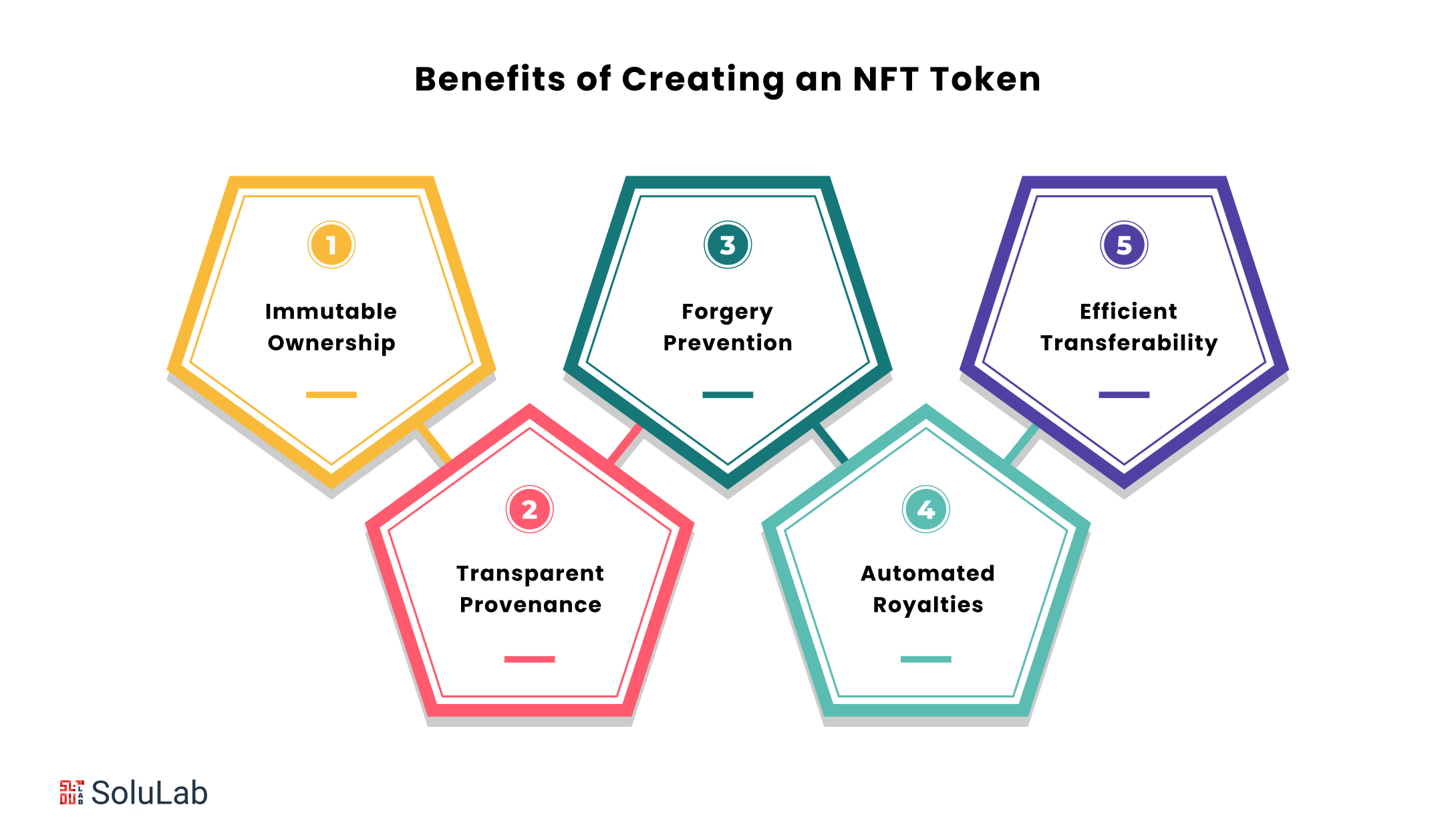
Creating an NFT token brings unparalleled benefits to artists and content creators. From establishing indisputable ownership and providing transparent provenance to unlocking automated royalties through smart contracts, NFTs redefine the digital landscape, offering unique monetization opportunities and fostering a global audience reach.
Let’s have a look at some of the benefits of creating an NFT Token:
-
Immutable Ownership
Blockchain technology, the cornerstone of NFTs, introduces a paradigm shift in establishing ownership. Unlike traditional digital files vulnerable to replication, NFTs harness the blockchain’s immutability to grant creators and collectors indisputable proof of ownership.
-
Transparent Provenance
NFTs redefine asset provenance by providing a transparent and immutable history. The blockchain records every transaction, creating an unassailable ownership trail that not only enhances the asset’s value but also assures collectors of its legitimacy.
-
Forgery Prevention
Addressing a persistent issue in the art world, NFTs utilize blockchain’s unique features to prevent forgery and counterfeiting. Each NFT is distinct, making duplication or tampering impossible, thereby guaranteeing the authenticity and integrity of the digital asset.
-
Automated Royalties
NFTs empower creators with a groundbreaking revenue stream through smart contracts. These contracts automatically trigger royalty payments to the creator with each resale of the NFT, allowing artists to benefit from the appreciation in value and subsequent resales of their work.
-
Efficient Transferability
NFTs streamline the transfer of digital assets, eliminating the complexities associated with physical art or collectibles. With minimal friction, NFTs can be traded on various marketplaces and effortlessly transferred between wallets or platforms, providing global accessibility for creators and expanding their potential market reach.
Final Words
In conclusion, as we navigate the intricate world of how to create NFT tokens in 2025, it’s evident that these digital tokens have transcended mere assets to become transformative tools for creators. With immutable ownership, transparent provenance, and automated royalties, NFTs provide an unprecedented avenue for artists to monetize their digital creations while offering collectors a unique, authenticated experience.
For those ready to embark on their NFT journey, partnering with a reputable development company is essential. SoluLab stands out as a trusted NFT Token development company, offering a suite of services to bring your digital vision to life. With expertise in blockchain technology and a commitment to delivering modern NFT development services, SoluLab provides the guidance and support needed to navigate the complexities of the NFT industry. Whether you’re an artist exploring the world of NFTs or a business seeking to leverage this innovative technology, SoluLab is your reliable partner in transforming ideas into reality. Explore the endless possibilities of NFTs with SoluLab – where innovation meets expertise.
FAQs
1. What is the significance of NFTs for content creators?
NFTs offer content creators unprecedented opportunities by providing verifiable ownership, transparent provenance, and automated royalty mechanisms. These digital tokens empower creators to monetize their digital assets in novel ways while ensuring authenticity and traceability.
2. How do NFTs address the issue of forgery in the art world?
NFTs combat forgery by leveraging blockchain technology, ensuring each token is unique and tamper-proof. The transparent and immutable nature of the blockchain creates a foolproof system that guarantees the authenticity and integrity of digital artworks.
3. What challenges do NFTs face in terms of market volatility?
NFT prices can be influenced by factors like market trends and speculation, introducing an element of volatility. Creators and investors need to be aware of this fluctuation, understanding that NFT values can experience rapid changes, potentially impacting financial returns.
4. How can emerging artists overcome barriers to entry in the NFT space?
While NFTs offer new opportunities, barriers such as technical knowledge, platform fees, and transaction costs can be challenging for emerging artists. Seeking community support, leveraging user-friendly platforms, and staying informed about the evolving NFT landscape can help aspiring creators navigate these obstacles.
5. How can businesses venture into NFT development, and what role does SoluLab play?
For businesses interested in NFT development, SoluLab is a leading NFT development company offering comprehensive services. From conceptualization to execution, SoluLab’s expert team guides businesses through the complexities of NFT development. To explore the possibilities, businesses can hire NFT developers from SoluLab, benefiting from their expertise and commitment to delivering modern solutions in the evolving NFT ecosystem.





